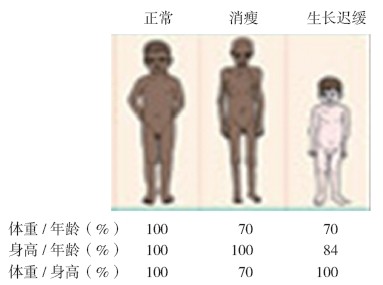 PDF(1210 KB)
PDF(1210 KB)


 PDF(1210 KB)
PDF(1210 KB)
 PDF(1210 KB)
PDF(1210 KB)
儿童营养状况评估研究进展
Research advance in assessment of nutritional status of children
儿童营养不良不是单一疾病,而是一种异常的状态,包括营养低下和营养过度。但多数国家学者描述儿童营养不良时仍是指儿童能量-蛋白质营养低下。根据体格发育指标判断儿童营养不良有低体重、生长迟缓和消瘦三种情况。身长(高)的改善比体重的增加更能衡量营养补充状况,体重增加应与身长(高)成比例。因此,近年WHO建议以体重/身长(高)判断儿童人群营养不良流行强度和个体儿童营养不良状况以及评估干预情况。评价儿童营养状况包括人体测量(“A”)、实验室或生化检查(“B”)、临床表现(“C”)、膳食分析(“D”)。营养不良儿童要求保证食物摄入Ⅰ类(功能性、预防性营养素)和Ⅱ类(生长营养素)等30余种营养素使生长加速至正常水平。
Malnutrition is not a simple disease, which occurs in the condition when the body does not get the right amount of nutrients to maintain healthy tissues and organ functions. Malnutrition generally refers both to undernutrition and overnutrition, but usually it is used to refer solely to a deficiency of nutrition. Infants and young children are the most vulnerable because of their high nutritional requirements for growth and development. Growth is an important indicator of health and nutritional status of a child. Generally, underweight, studding and wasting are used as the indicators of malnutrition. In fact, a gain in height is a better indicator of the adequacy of a diet than a gain in weight. Rates of weight gain needs to accompany accelerated height gain to maintain normal body proportions (weight-for-height). Now therefore WHO recommends using weight-for-height as the indicator of malnutrition of epidemic intensity in communities and of nutritional condition evaluation, including treatment assessment. The assessment of nutritional status is commonly summarized by the mnemonic "ABCD", which stands for anthropometric measurement (A), biochemical or laboratory tests (B), clinical indicators (C) and dietary assessment (D). Children with malnutrition are required to ingest more than 30 essential nutrients including both functional, protective nutrients (type I) and growth nutrients (type Ⅱ), in order to have a catch-up growth in weight and height.

Malnutrition / Nutrition assessment / Height / Weight / Child